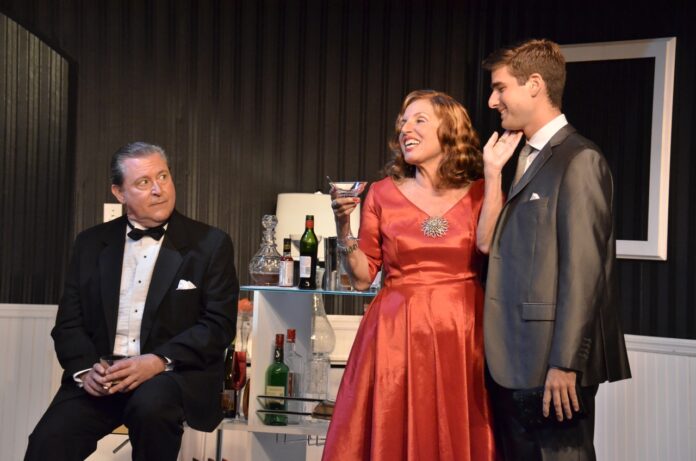
Now onstage at Key West’s Red Barn Theatre, “The Code” conjures the glitter and glamour of 1950s Hollywood.
But there’s a dark side.
The four-actor play tells the tale of former matinee idol Billy Haines (played by Tom Wahl), a semi-closeted homosexual who laments the state of affairs in which gays are shunned in show
business and same-sex relationships are still regarded as “deviant” by the House Un-American
Activities Committee.
Haines’ gal pal Tallullah Bankhead (Mary Falconer) and friend Henry Wilson (David Black) are joined by tagalong young actor Chad Manford (Carlos Ortega Amorin). Hanging with Haines in his stylish living room with its black-and-white checkerboard floor, the Los Angeles trio laments Hollywood’s dreadful socio-political mores.
Playwright Michael McKeever crafted “The Code” in 2021 as a period-piece parable intended to
illuminate the hypocrisy of a movie-making era in which studios operated with an eyes- wide-shut agenda toward gays.
All this “in a town built by homosexuals that will not acknowledge that they exist,” says Bankhead, who adds with a chuckle, “This entire town is a cesspool.”
The show’s director, Christopher Renshaw, said his passion for McKeever’s message drove him
to get “The Code” onstage in Key West after a previous run at Fort Lauderdale’s Foundry in
Wilton Manors.
“It’s horribly relevant,” he noted after the play’s March 6 dress rehearsal at Red Barn Theatre. “In Tennessee they are trying to outlaw drag queen shows. I’ve been in theater all my life and that has historically always been the most accepting place for us.”
Artistic director Joy Hawkins added, “I think it’s important work that’s being done on this subject.”
“The Code,” which runs through March 25, is a 90-minute comedy whose edge needs little
explanation.
“I’m a lesbian, and what do you do?” Bankhead queries the audience early in the performance. The fledgling actor Manford is a manufactured star, battered by the Svengali-style agent Wilson to dump his gay lover by way of an immediate phone call.
“But I love him and he loves me,” Manford cries.
The slimy agent’s move highlights the heartbreaking sacrifice that, in a not-so-distant era of Hollywood, was seen as the only way to protect an acting career. McKeever’s compelling narrative details the efforts to falsify perceptions and hide the details of an actor’s personal life.
The audience sees Haines shift his focus from performing as a major screen star in the 1930s to launching a career in set design, mostly due to the pressures of hiding his homosexuality.
His plans to move to upstate New York with his partner Jimmie and buy an apple farm has Bankhead in hysterics, but also pleading with her friend to stay in L.A.
“You’re the only thing in this town I don’t hate,” she quips.
The soul-crushing implications of one’s personal sexual identity getting in the way of ambition and talent is the recurrent theme in “The Code.”
British-born Renshaw’s direction is unsurprisingly tight given his impressive history of bringing stories to the stage. His Broadway production of “The King and I” has garnered four Tony awards. Renshaw also co-produced “We Will Rock You” with the band Queen and Robert DeNiro. The director’s credits evince a skillful dedication to live theater here and abroad.
As “The Code” comes to a close, McKeever’s message is clear. The bigotry toward America’s
LGBTQ performing arts community is its own paradox, as the very same people produce so much of the entertainment enjoyed by millions.
“Your plight may someday be someone’s salvation,” Bankhead says hopefully of Haines’ singular sacrifice on the altar of personal freedom.























